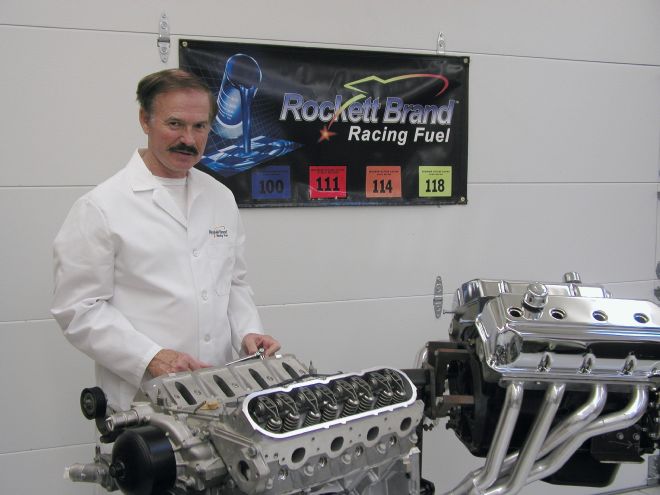
Recently, we had the opportunity to sit down and chat with Tim Wusz, vice president of engineering at Rockett Brand Racing Fuels, on the subject of racing gasoline. Like most of us, Tim is a performance enthusiast; he is also a mechanical engineer with a degree from Oregon State University and has a remarkable knowledge on the subject of racing fuels. Tim worked for Union Oil Company of California in R&D for 29 years, until downsizing and corporate restructuring lead to the 76 brand being owned by several oil companies over the next 10 years. Tim spent these 10 years building the line of 76 Racing Gasoline products working with NASCAR, NHRA, and many others.
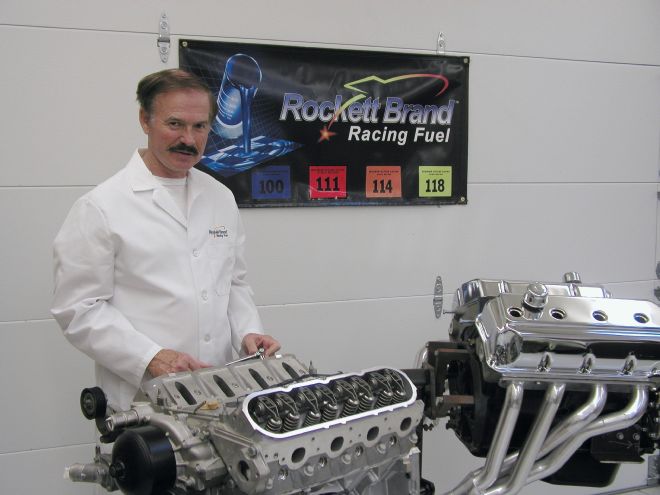
Corporate downsizing caught up with 76 Racing Gasoline at the end of 2004 when the owner of the 76 brand, Conoco Phillips, elected to get out of motorsports and out of the racing gasoline business. Rockett Brand Racing gasoline was formed at that time by a former employee of the 76/Tosco/Phillips/ConocoPhillips mergers. With a background in petroleum product development, including gasoline and lubricants, Tim was a logical choice to head the technical side of this new company.
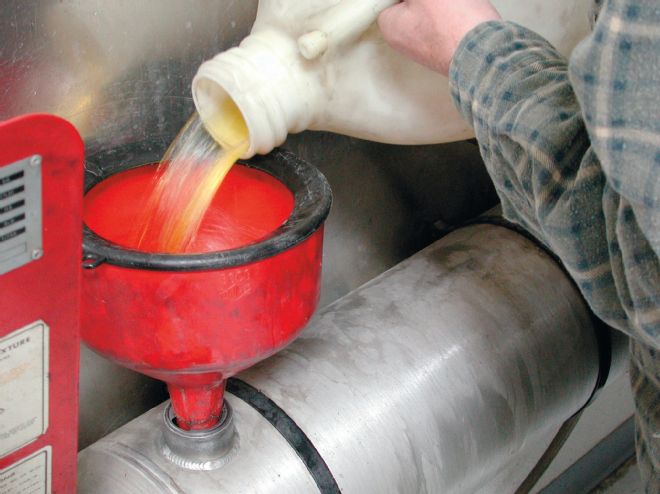 We spend enough time filling the dyno fuel tank when testing engines to know that the fuel, particularly the octane, has to match the application. Detonation, especially under boost or when running nitrous, can destroy an engine very quickly.
We spend enough time filling the dyno fuel tank when testing engines to know that the fuel, particularly the octane, has to match the application. Detonation, especially under boost or when running nitrous, can destroy an engine very quickly.
Tim holds five patents on fuel-related items and provided support on several other patents. He was also actively involved in drag racing for 15 years racing an "A" Street Roadster, an "A" Altered, a front engine dragster, and a rear engine dragster. When it comes to the field of racing fuels, Tim has an expertise that few can match.
EM: Tim, what is gasoline?
Tim: Gasoline is a mixture of a whole lot of different hydrocarbons. For instance if you did what is called a hydrocarbon analysis to find out how much of each of these different hydrocarbons are in a street gasoline, you'll find there are about 400 different hydrocarbons. Most of them are in small amounts, because they just come along in the refining process, because you can't separate every different hydrocarbon. There will be some that are pretty typical, that you would expect to see, and then a lot of little fractional ones that make up the rest of the components. In a racing gasoline we try to cut that down, and generally we are well under 100 different hydrocarbons, and of those there are five or six that are very significant, and the rest are some of these little trivial ones.
EM: What are the main components in a base gasoline stock?
Tim: In a good gasoline, the backbone of the gasoline is the alkyd, and then you have some lighter components such as butanes and pentanes that are used on what we call the front end of the gasoline, to help get the engine started on a cold start. The alkyd in our unleaded racing gasoline represents in the area of 60-70 percent.
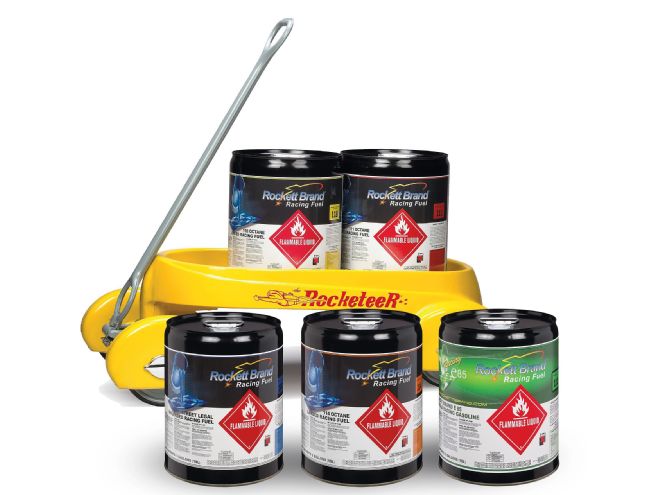 Rockett Brand offers a wide range of racing gasoline at different octane ratings, allowing the enthusiast to select the grade suitable for the engine combination. The vast majority of our engine dyno testing is done with Rockett Brand Fuel.
Rockett Brand offers a wide range of racing gasoline at different octane ratings, allowing the enthusiast to select the grade suitable for the engine combination. The vast majority of our engine dyno testing is done with Rockett Brand Fuel.
EM: What differentiates a racing gasoline from ordinary pump gasoline?
Tim: The obvious thing here is the octane number. You need a higher octane number for a greater resistance to detonation, because a racing engine makes much more cylinder pressure and runs a greater percentage of the time under wide-open throttle conditions. We selectively pick the components that go into the racing gasoline. A lot of people think you just start with street gasoline and add things to it. We select the components to get the characteristics we want; there's no compromise. At high rpm, as in a racing engine, you want the fuel to burn quickly. You don't have a lot of time because the combustion process goes very, very fast. We pick components that burn quickly, vaporize readily, have good octane qualities, and in the case of leaded gasoline, components that respond well to lead.
EM: When you refer to fuel component, what does a fuel component consist of?
Tim: We are talking about things like toluene, xylene, butane, and pentane; there are a whole variety of different kinds of components. We like a clean alkyd. Alkyd is the backbone of a racing gasoline, but there are a lot of different alkyds, and there are a number of different hydrocarbons, but of similar characteristics. They all respond well to lead. When they come off the unit at the refinery, there are some of them that are what we refer to as narrow cut, and some are wide cut. The wide-cut alkyd has a lot of less desirable things in it that goes into street gasoline, but in the case of racing gasoline, we like the narrow cut.
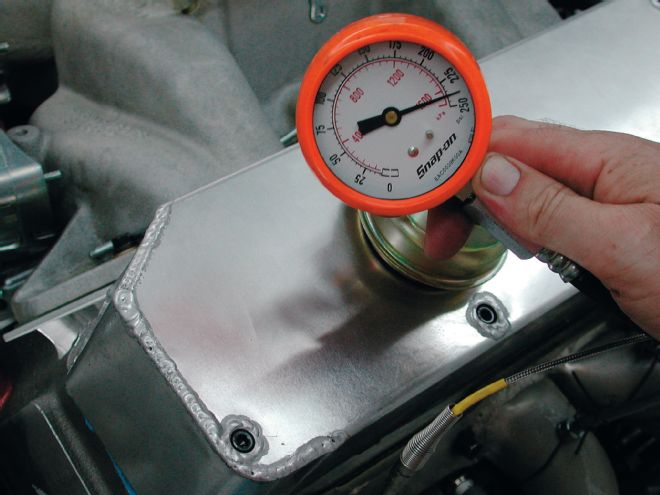 Cylinder pressure is one of the key contributors to detonation. Compression ratio is usually the key factor in cylinder pressure, but cam timing and mechanical efficiency also play a significant role. With 240 psi of cranking compression, this big-block Chrysler would normally be in race gasoline territory.
Cylinder pressure is one of the key contributors to detonation. Compression ratio is usually the key factor in cylinder pressure, but cam timing and mechanical efficiency also play a significant role. With 240 psi of cranking compression, this big-block Chrysler would normally be in race gasoline territory.
EM: It sounds like the components you mentioned are additives, would that be correct?
Tim: Well, they are not really additives, they are chemicals, and we call them blending components. In the case of some, people do use them as additives, if they are readily available. The racing gasoline is generally already optimized. If you start adding additives, you can end up upsetting the fuel's characteristics. You might gain some on the octane side, but you'll give up some on what's really burned in the combustion chamber, and that is just wasted energy.
EM: From our discussion it seems as though the fuel chemist has a number of different ingredients to put into the fuel recipe. What are some of the guidelines in blending a very good fuel?
Tim: You want to select components that will vaporize readily and that do have a good octane quality. That is one of the advantages of making a racing gasoline; you get to select your own components. You don't have to compromise like you do with a street gasoline. Some of the street gasolines have some low-octane components that help to smooth out the distillation curve, which is the rate at which everything vaporizes. For a racing gasoline, since we are generally running at wide-open throttle, you are not quite as concerned about a really smooth distillation curve.
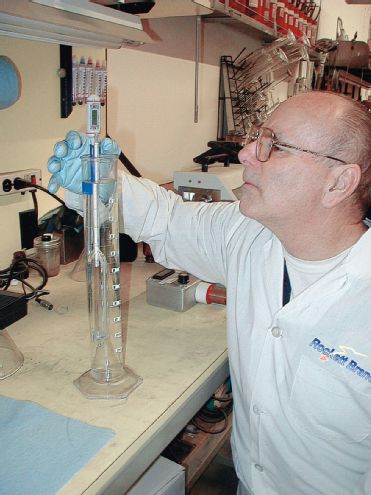 Racing gasolines are blended from primarily hydrocarbon components, each with its own characteristics in the final gasoline blend. Many considerations besides octane determine an excellent racing gasoline.
Racing gasolines are blended from primarily hydrocarbon components, each with its own characteristics in the final gasoline blend. Many considerations besides octane determine an excellent racing gasoline.
EM: Tim, can you elaborate a little on the term distillation curve?
Tim: When you take for instance water, it vaporizes at 212 degrees (F) at standard barometric pressure. When you do the same thing with gasoline, it will vaporize over a range. A typical racing gasoline will start vaporizing at around 100 degrees (F), and keep going on up to 250 degrees, or in some cases the way some folks blend gasoline, quite a bit higher than that. If you were to heat gasoline up, and there is a standardized test for this, some of it will start to boil at 100 degrees, and you will have to keep putting more and more and more heat into it to keep boiling off all of the components that boil at a higher temperature. The higher temperature ones are the more difficult ones to vaporize.
If the fuel doesn't vaporize well in the intake manifold, especially in a carbureted vehicle, it takes more finite time to vaporize in the combustion chamber, and you're not likely to get it all vaporized and burned in the short time that you have. So, the distillation curve is very important. You don't want to have heavy stuff in a racing gasoline that is going to boil at 350 or 400 degrees, because it is likely not to function well in the engine.
EM: Can you give a quick rundown of the racing gasoline products from Rockett Brand, and what each would be appropriate for?
Tim: The lowest octane fuel we make is the 100-octane unleaded. This fuel is legal in all 50 states and is compatible with emissions equipment. It is designed for higher performance cars and works well in the older muscle cars, as well as the later-model stuff that has forced induction, or anything that adds cylinder pressure. In some cases guys use this higher-octane fuel in normally aspirated muscle cars from the '60s, because the bigger bores of these engines need more octane; you have a bigger chamber you are trying to satisfy the demand in. There were some engines from that era that were really bad as far as having hot spots and difficulty with detonation in the combustion chambers. The thing that has really helped with that is outfits like Edelbrock that have made aluminum cylinder heads with current casting technology, as well as going from cast iron to aluminum, although many of the purists still stick with their cast-iron stuff.
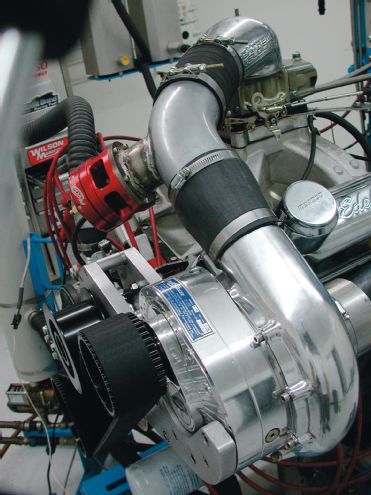 High-boost applications, such as this engine fitted with a F1R ProCharger centrifugal supercharger, require sufficient fuel quality to prevent detonation. Better fuel means you can run more boost and make more power.
High-boost applications, such as this engine fitted with a F1R ProCharger centrifugal supercharger, require sufficient fuel quality to prevent detonation. Better fuel means you can run more boost and make more power.
We also have three leaded fuels 111, 114, and 118 octane. Each of these is designed for a little bit of a different application, depending on how much cylinder pressure your engine has. We have it pretty well spelled out on our website as to what works best. For instance, the typical Saturday night roundy-round guy is going to use the 111-octane gasoline. We have a lot of Supercomp and Supergas cars at the drags that use the 114 octane. The 118 octane is more for all-out competition, with high-rpm applications and/or engines with very big cylinder bores. The 118 octane is also used in some supercharged or turbocharged applications where guys are just going crazy with the boost.
EM: How difficult is it to blend that additional octane in, let's say going from the 100-octane fuel to the 118, and still have a viable racing fuel?
Tim: You do it a little bit differently with the 118 than you do with the 100. With the 100, without any lead in it, we are looking at components that have good octane without adding lead to it. That fuel has to be a legal EPA, CARB-type of gasoline. In the 111-, 114-, and 118-octane fuels, they all do have tetraethyl lead in them. That is still legal to use in racing gasoline and aviation gasoline. We select components there that respond well to lead. Some respond better to lead than others, and you want to get the most that you can out of it, so it is still a pretty tight selection process, but just a little bit different than what you would do with the unleaded product.
EM: Do your various leaded racing gasolines vary in lead content?
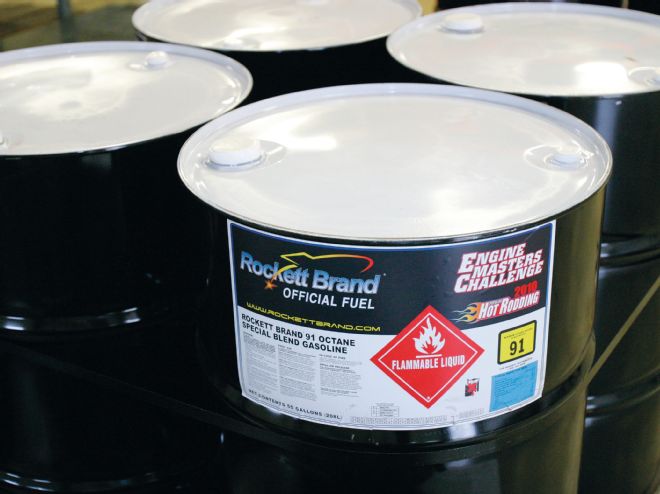 Rockett Brand was the official fuel for the 2010 Engine Masters Challenge. Since we require 91-octane unleaded, and this is not a part of Rockett's specific product line, the fuel was specially blended for the event.
Rockett Brand was the official fuel for the 2010 Engine Masters Challenge. Since we require 91-octane unleaded, and this is not a part of Rockett's specific product line, the fuel was specially blended for the event.
Tim: Yes, they do. The 111 has a lower level, the 114 is intermediate, and the 118 is a higher level.
EM: How much lead are we talking about in grams per gallon?
Tim: On the 118 in round numbers it is about 6 grams per gallon, the 114 has 5 grams per gallon, and the 111 has a little less than 4.
EM: How is the fuel's octane rated?
Tim: The octane rating is research octane plus motor octane divided by two. We tried to keep ratings consistent like that since that is what is used for street gasoline. Most guys understand that system and ours is really no different.
EM: How are the octane ratings determined?
Tim: The octane numbers are determined in an octane engine, which is a single cylinder, variable compression ratio engine. Operating conditions are different for the research number than it is for the motor number, but the testing hardware is similar. There is a standard ASTM test procedure for conducting that test.
EM: Let's speak about some of the other specifications that you would find on a gasoline tech sheet.
Tim: The one that is the most important to the tune is the oxygen content of the gasoline. In the case of the Engine Masters Challenge gasoline the oxygen content was 3.8 percent, and that is because there is some ethanol in the gasoline. What ethanol or any kind of alcohol does to a gasoline is it helps to raise the octane number a little bit, but where it also helps is in the combustion process. You are putting a little bit more oxygen in with the gasoline, so instead of getting all of your oxygen from the air, you are getting some of it from the fuel. It potentially improves the power output of the engine if you tune for it. You richen it up appropriately to take care of getting enough fuel in there where you can burn all the fuel and have just a very small amount of unburnt hydrocarbons going out.
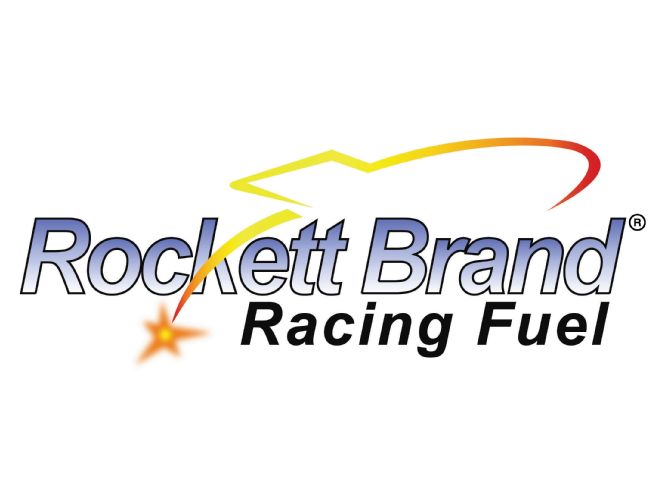
EM: Is there any other specification given for the fuel besides the oxygen content that will point to a required tuning change?
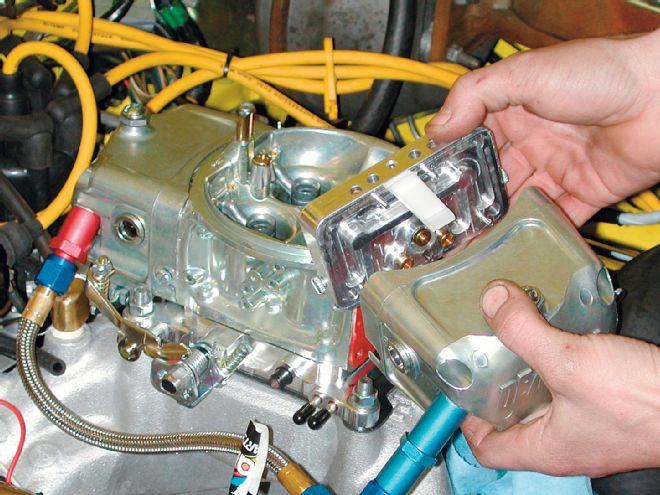 Jetting requirements can vary with the fuel poured in the tank. The two main specifications of the fuel affecting jetting are the specific gravity and the oxygen content. As the specific gravity goes down, or the oxygen content increases, you will need to jet up to compensate.
Jetting requirements can vary with the fuel poured in the tank. The two main specifications of the fuel affecting jetting are the specific gravity and the oxygen content. As the specific gravity goes down, or the oxygen content increases, you will need to jet up to compensate.
Tim: If you are changing gasoline, and there is a change in the specific gravity. Let's say your new gasoline is a lower specific gravity than your old gasoline. That means it is a little bit lighter, and to maintain the air/fuel ratio you are going to have to put more fuel in. So if the specific gravity goes down, you are going to have richen the mixture. For instance, if you go from .735 to .725 on the specific gravity scale, you can figure about one jet size. If you go from .725 down to .715, you go another jet size. It's kind of a ballpark, but it gets you moving in the right direction.
Also, when there is oxygen in the fuel it is important to richen it up to compensate for that extra oxygen.
EM: Thank you, Tim. As always you have been very informative. EM